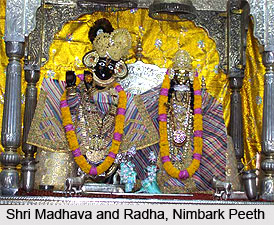 Salemabad Nimbark Peeth in Ajmer is an ancient pilgrimage centre which was established by the Bhati chief of Gopal Singh Ji Bhati and Khejarli Shri Sheoji during 1520 or 1463 AD. It is believed that he had created this religious site on the instructions of the saint Shri Nimbarkacharya Peethadhishwara Shri Parashu Ram-Devacharya Ji. The temple has been erected in a unique process such that the holy deity can be viewed by its visitors immediately after they enter the temple, for `Darshan`. The `Garbha Griha` has been manufactured in a way so that that the pure moonlight of `Sharad Purnima` reaches the lotus feet of the idol of Lord Krishna, of the `Radha-Madhav`, sharp at 12.00 p.m. Marble pillars of the temple are beautified with exquisite carvings and the central portion of the temple is transparent. The temple occupies an area measuring 42, 000 square feet.
Salemabad Nimbark Peeth in Ajmer is an ancient pilgrimage centre which was established by the Bhati chief of Gopal Singh Ji Bhati and Khejarli Shri Sheoji during 1520 or 1463 AD. It is believed that he had created this religious site on the instructions of the saint Shri Nimbarkacharya Peethadhishwara Shri Parashu Ram-Devacharya Ji. The temple has been erected in a unique process such that the holy deity can be viewed by its visitors immediately after they enter the temple, for `Darshan`. The `Garbha Griha` has been manufactured in a way so that that the pure moonlight of `Sharad Purnima` reaches the lotus feet of the idol of Lord Krishna, of the `Radha-Madhav`, sharp at 12.00 p.m. Marble pillars of the temple are beautified with exquisite carvings and the central portion of the temple is transparent. The temple occupies an area measuring 42, 000 square feet.
Nimbark Peeth is associated with the `Sri Nimbarka Sampradaya` which is said to be the oldest Vaishnava Sampradaya, and follows the `Dwaitadwait` philosophy. This Indian philosophy was first propagated by Hans Bhagwan to Sri Sankadi Bhagwan, then to Sri Narada Muni and finally to Sri Sudarshana, Chakravatar Jagat Guru Nimbarkacharya. The basic concept of the theory is the worship of Sri Radha Madhav, and Radha has been asserted as being an inseparable portion of Lord Krishna. Shri Nimbarka Peetha is said to be the only of this Indian Sampradaya which boasts of over a million followers.
The `Shaligram` idol of Shei Sarveshwar Prabhu is one of the principal deities of the Nimbark Peetha and is revered as one amongst the most sacred deity. This Shaligram is believed to be one of its kind in the entire world and is worshipped since ages, by Devarshi Narad, Sanaka brothers, Jagatguru Shri Nimbarkacharya and the several `Acharyas` of the Nimbarkacharya Peeth. The Acharyas always carry the Shaligram along with themselves wherever they go. Thakur Shri Madhav is another important deity who is referred to as `Gokulchandramaji`. Its idol has been established at Nimbarkapeetha according to the `Shrigopaltapani` at Atharva Veda. It is believed that the observers of this holy idol brings great luck to all devotees and are blessed by the deity. The famous poet Shri Jayadev had also worshipped this very idol, and there exists an interesting legend associated to the idol of Shri Madhav.
Visitors to this pilgrimage centre will come across the Acharya Mandir which is situated in the southern direction from the idol Shri Radhamadhavji and Sarveshwar Bhagavan. One can observe Shri Nimbark, Shri Hans, Shri Narad, Shrinivasacharya and Shri Sanakadhik here. The Ved Mandir is based in the northern direction from the Shri Sarveshwar Prabhu. The Siddha Peeth is located at the southern part of the Acharya Mandir.





















